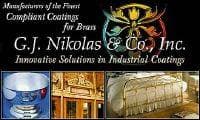
Curated with aloha by
Ted Mooney, P.E. RET

The authoritative public forum
for Metal Finishing 1989-2025

-----
Acid washing of brass elevator doors
Q. I have a customer who I do a lot of furniture refinishing for. He has two elevators in his condo. Both have polished brass doors inside and out, with brass trim inside. He told me that a company once came in and "acid washed" (?) the doors. Ever since then the doors have required daily polishing and maintenance. He wants me to finish the doors to cut down on the maintenance. I have not been able to find any information on lacquering or prepping brass or even if lacquer is the most desirable material to use. Any information or direction on this subject would be greatly appreciated.
JEFFREY PASTOR- Commercial Furniture Repair
1998
A. Dear Jeff:
Lacquer is used by the leading metal maintenance companies refinishing elevators and hardware in most major cities.
The process is to strip the old coating, polish the brass, clean the surface and spray the clear lacquer topcoat.
Regards,
Les Trinity- Middlesex, New Jersey
1997
A. Jeff:
This finishing work is a bit tricky to accomplish on your own. Companies specialize in such finishing work, and literally refinish thousands of elevators a year.
Thanks,
Tom Stoub- Kingwood, Texas
1997
A. Dear Jeff:
I am with an architectural restoration company. The procedure for restoring elevator doors on site is very difficult and I agree with Tom that this job should only be done by someone who is knowledgeable due to the fact that untrained persons can cause more damage than good in their attempt to refinish the doors. Your indication that someone had previously used acid to clean the doors is a prime example of that.
Gordon S. Ponsford- Acworth, Georgia
1998
A. We refinished 108 copper elevator doors which came from the factory with a lacquer finish; right out of the box and before installation they were already corroding. Lacquer has an advantage, it is easy to remove and refinish; however it is not durable.
Solution; make a mixture of 2% benzotriazole ⇦ this on eBay or Amazon [affil links] and quality lacquer thinner ⇦ this on eBay or Amazon [affil links] Warning! highly flammable! , spray (not too wet) onto any cupric metal (brass, bronze or copper) after cleaning the surface with VMP naptha. This will result in a "snowflake" pattern on the metal once the thinner flashes, within 20 min. spray isocyanate catalyzed automotive urethane, PPG DU 1000 is good or DU 85 (not as much solids).
First one tack coat followed by two wet coatings. Make certain to coat the edges to prevent cupric rot.
The 108 elevator doors have been exposed to exterior Hawaiian environment 100 yards from the ocean for 5 years now and have shown no corrosion. Always test technique first on scrap material to refine skills.
Roger Worldie- Honolulu, Hawaii
2003
![]() Thanks for the carefully detailed answer, Roger!
Thanks for the carefully detailed answer, Roger!
Regards,

Ted Mooney, P.E.
Striving to live Aloha
finishing.com - Pine Beach, New Jersey
Q. We have an old brass elevator, the cleaners while stripping the floor got stripper on the bottom of the brass which removed the lacquer. do I need to refinish the whole elevator or just the bottom where the damage is done. how would I remove the old lacquer and what product should I use to clean and refinish?
Janet Killian- Wilmington, Delaware
2007
Q. How can I get stain marks from carpet cleaning solution splashed onto elevator doors and kick boards?
Lance PattockMaint manager - Portland, Oregon
August 20, 2008
Q. I need to know how to cut a circular groove pattern into a brass elevator door. The hotel where the elevator is located is having problems with people "keying" (scratching) the doors. The doors will require a rough finish with a circular half moon pattern.
Larry Bordeauxbrass polishing works - Raleigh, North Carolina
2004
A. Hi Larry. If I understand your question, you are asking how to do what people variously call a "dowel finish", "jeweled finish", "engine turned finish" and several other names. Please see thread 13213 but note that you would only be able to do this with the door removed and on a drill press.
Regards,

Ted Mooney, P.E.
Striving to live Aloha
finishing.com - Pine Beach, New Jersey
Q. I have several elevator doors that are a "Brushed Brass Finish". My boss wants them to have a brighter (gold) look when I refinish them. I have found that I can apply Noxon 7 ⇦ this on eBay or Amazon [affil links] with a Scotch Brite Pad to polish them to a brighter finish, then I apply a clearcoat to protect them, however it takes quite a bit of time and I have lots of "scuff marks" that I am sure will be more pronounced on the larger surfaces when I am done.
Does anyone have any suggestions on other methods to ensure a more consistent pattern and maybe even cut the time it is taking me ?
Thank you,
Kenny E [last name deleted for privacy by Editor]- Louisville, Kentucky
A. Dear Kenny,
A gold-dyed lacquer may help. It would take many thin coats to provide a uniform finish over large areas such as elevator doors. This would take a great deal of practice to achieve that technique, so maybe the way you're doing it now might be best. A lot of clearcoats contain additives that would "telegraph" the buff marks, almost magnifying them. Maybe a coating that didn't do that could help as well.
Good luck,
Jake KochG. J. Nikolas &Co.,Inc.
Bellwood, Illinois

A. Kenny, you must stay with the grain. G.J. Nikolas [a finishing.com supporting advertiser] does make a good product. We do this type of metal refinishing on a regular basis. It takes a lot of practice and the right equipment.
Thanks,
Dennis B [last name deleted for privacy by Editor]- Louisville, Kentucky
2000
Q. Do you restore brass elevators? I have never done a brass elevator, only stainless steel. I just did a test spot on one today and it polishes the brass immediately. It appeared that there was some type of coating or patina that the manufacturer put on it. So far the manufacturer does not know what it is. Please help if you can. It is an OTIS elevator if that helps.
Tom Cigno- Avon, Colorado
October 8, 2010
Elevators discolored by ammonia-based cleaning solution?
Q. Our building has elevators whose entryways are framed with a brushed-brass-finish metal which seems to have a clear finish on it. Over the last few years this metal has discolored, sometimes in the shape of droplets that have run down the vertical surfaces, others times a more general darkening. My question: what could have discolored the coating itself? It's not paint, and it's not just surface schmutz. Could an ammonia-based liquid cleaner have darkened the clearcoat?
David WareMr. - Little Rock Arkansas, US
August 8, 2018
A. Hi David. Although it would surprise me if ammonia ⇦ this on eBay or Amazon [affil links] discolored the clearcoat, it would not surprise me that the clearcoat has grown porous and ammonia is reacting with the underlying brass, causing the discoloration.
Although some clock repairers disagree, most feel it's generally not a good idea to use ammonia on brass because copper is soluble in ammonia, which creates a number of problems.
I also think no clearcoat is so perfect as to prevent brass from gradually discoloring over a period of years.
Regards,

Ted Mooney, P.E. RET
Striving to live Aloha
finishing.com - Pine Beach, New Jersey
August 2018
A. Hello, brass surfaces will Tarnish when exposed to air and chemicals, therefore they must be coated with clear protective lacquer to prolong its beautiful rich 'gold' appearance. Improper cleaning products and abrasives will wear down the lacquer finishes applied by factory over time, thus exposing the raw metal to these elements. Once they are, they will turn dark brown to air and green tones to chemical metal cleaners. REMEDY: Strip entire surface of remaining lacquer using abrasive pads and water to remove tarnish and scratches. Spray apply new clear lacquer finishes to protect refreshed surfaces from chemicals and air.
adv.
You can always reach us at www.barrysrestoreitall.com for more direction.

Barry Feinman - Chief Restoration Officer
BarrysRestoreItAll
Carlsbad, California

November 9, 2018
Q, A, or Comment on THIS thread -or- Start a NEW Thread